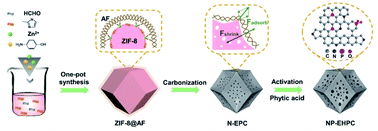Nitrogen, phosphorus co-doped eave-like hierarchical porous carbon for efficient capacitive deionization†
Abstract
Carbon-based electrodes play important roles in constructing efficient capacitive deionization (CDI) devices. Therefore, the rational design of carbon materials with optimized structure, composition, and morphology is crucial for further improving the CDI performance. Herein, a novel N, P co-doped eave-like hierarchical porous carbon (NP-EHPC) for CDI is reported. To prepare the NP-EHPC, the core–shell ZIF-8@AF particles are first prepared through the kinetically-controlled growth of zeolitic imidazolate framework-8 (ZIF-8) and polymerization of p-aminophenol and formaldehyde (AF), followed by subsequent pyrolysis and post-doping with phosphorus. Owing to the unique eave-like morphology, presence of abundant mesopores, and co-doping of P and N, the NP-EHPC exhibits a high desalination capacity of 24.14 mg g−1 in 500 mg L−1 NaCl solution at 1.2 V and long cycling stability of over 150 cycles. Moreover, the density functional theory (DFT) calculation results reveal that the co-doping of N and P atoms can greatly enhance the binding energies for Na and Cl atoms and lead to superior electrosorption capacity. This work provides a new insight into the design of high-performance carbon materials for the desalination of brackish water.



 Please wait while we load your content...
Please wait while we load your content...
